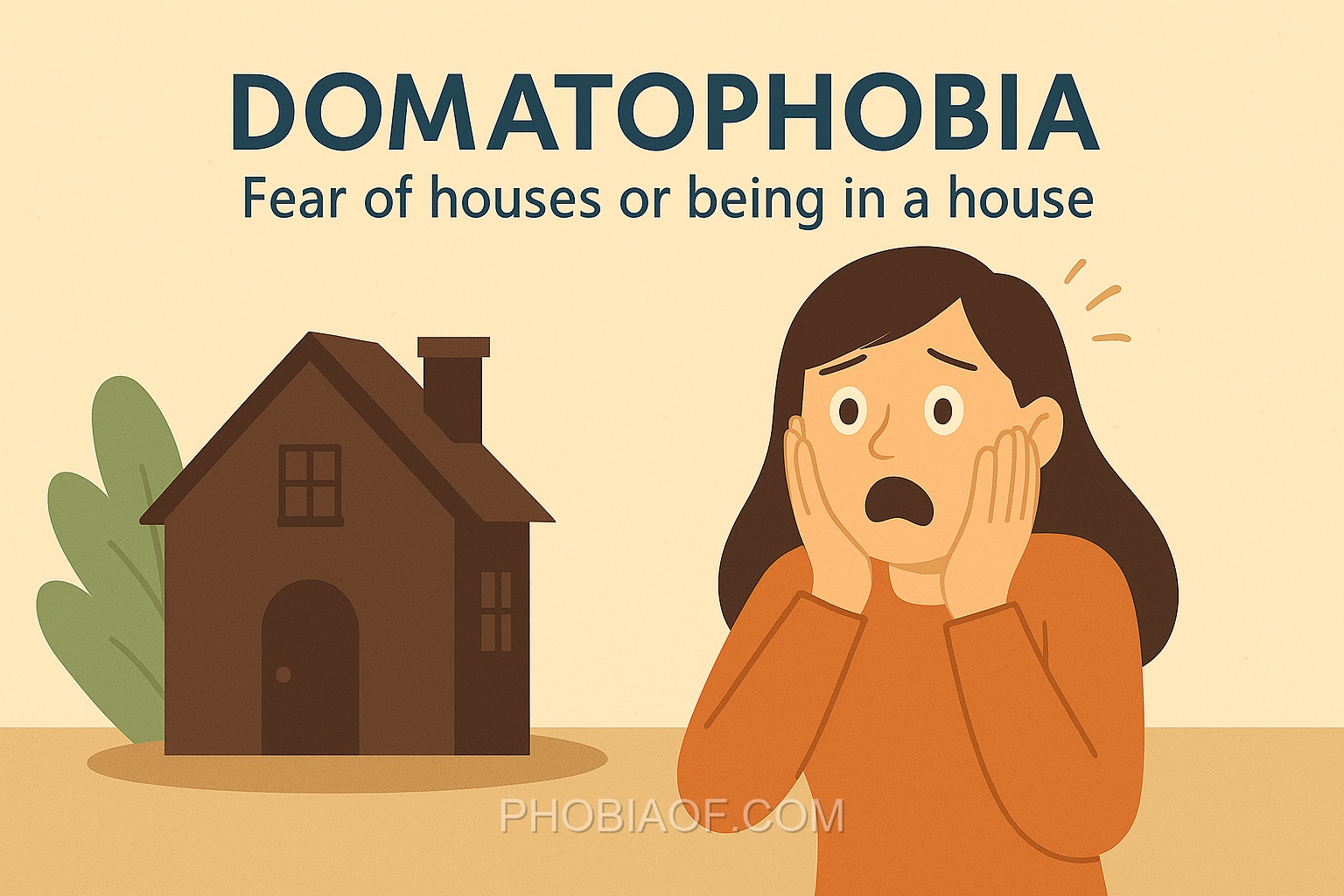Have you ever stepped into a house and felt an overwhelming sense of dread or panic? For some people, this isn’t just a fleeting feeling—it’s a persistent fear known as Domatophobia.
In simple terms, Domatophobia is the fear of houses or being inside one. The term is derived from the Greek word “domato,” meaning house, and “phobia,” meaning fear. While it might seem unusual to be afraid of something as commonplace as a house, this phobia can significantly impact a person’s daily life.
Individuals with Domatophobia may experience anxiety at the thought of entering a house, whether it’s their own or someone else’s. This fear can manifest in various ways, such as feeling trapped or overwhelmed by the enclosed space or the potential dangers they associate with being indoors.
Here are some common effects of Domatophobia:
- Avoidance of social gatherings or events that are held in homes.
- Discomfort or panic attacks when inside a house.
- Difficulty in maintaining relationships due to the avoidance of home settings.
- Stress or anxiety that interferes with daily activities and responsibilities.
Understanding Domatophobia is the first step toward addressing it. It’s crucial to approach this fear with empathy and seek professional help if it disrupts one’s life. Remember, you’re not alone, and support is available.
Causes of Domatophobia
Domatophobia, the fear of houses or being inside a house, can arise from a variety of causes. Understanding these potential origins is essential for those experiencing the fear and for those supporting them. Below are some of the common reasons why someone might develop this phobia:
- Genetic Predisposition:
Some people may have a genetic predisposition to anxiety disorders, including specific phobias like domatophobia. If a close family member has a phobia or other anxiety-related condition, there may be an increased likelihood of developing similar issues.
- Traumatic Experiences:
Experiencing a traumatic event inside a house, such as a burglary, fire, or domestic violence, can trigger domatophobia. The mind may associate houses with danger or distress, leading to persistent fear.
- Learned Behavior:
Domatophobia can also be a learned behavior. Observing a parent or significant figure expressing fear or anxiety about being inside houses can influence a person to develop similar fears.
- Psychological Factors:
Other psychological conditions, such as claustrophobia (fear of confined spaces) or agoraphobia (fear of situations where escape might be difficult), can contribute to domatophobia. The fear of being in a house might be linked to these broader anxieties.
- Environmental Factors:
Growing up in an unstable or chaotic home environment might also lead to domatophobia. If a house consistently felt unsafe or unpredictable, the fear of being in such a place could persist into adulthood.
While research specifically on domatophobia is limited, these causes align with general theories on phobia development. It’s crucial for those struggling with domatophobia to seek professional help, as understanding the root cause can aid in effective treatment. Therapy can often help individuals reframe their fears and gradually reduce anxiety associated with being inside houses.
Symptoms of Domatophobia
Domatophobia, the intense fear of houses or being in a house, can be a distressing experience for those who suffer from it. The anxiety associated with domatophobia can manifest in various ways, affecting both physical and emotional well-being. Recognizing these symptoms is a crucial step toward understanding and managing this phobia. Here are some common symptoms:
Physical Symptoms:
- Panic attacks characterized by intense fear and discomfort.
- Excessive sweating, especially when thinking about or approaching a house.
- Rapid heartbeat or palpitations when faced with the prospect of entering a house.
- Shortness of breath or hyperventilation in situations involving houses.
- Trembling or shaking at the thought or sight of a house.
- Nausea or gastrointestinal distress as a reaction to the fear.
Emotional and Behavioral Symptoms:
- Overwhelming dread or terror at the idea of entering or being inside a house.
- Persistent avoidance of houses or situations where one might have to enter one.
- Feelings of helplessness or loss of control when near a house.
- Difficulty concentrating or thinking about anything else when confronted with a triggering situation.
- Intense desire to escape or leave situations that involve being in a house.
- Emotional distress or irritability when discussing or planning activities related to houses.
When severe, these symptoms can significantly interfere with daily life, making it challenging to perform routine activities or maintain relationships that involve being in or around houses.
Treatment for Fear of Houses or Being in a House
If you or someone you know is struggling with Domatophobia, the fear of houses or being in a house, it’s important to know that this phobia can be treated and managed over time. With the right approach, you can overcome this fear and improve your quality of life.
Proven Therapies
- Exposure Therapy: This therapy involves gradually facing the fear in a controlled and safe environment. By slowly exposing oneself to the idea of being in a house, the fear response can be diminished over time.
- Cognitive-Behavioral Therapy (CBT): CBT focuses on changing the fearful thoughts associated with houses. This therapy helps in re-framing negative thought patterns into more positive and realistic ones.
- Counseling: Speaking with a counselor or therapist can provide a supportive space to explore the roots of the phobia and develop coping strategies tailored to individual needs.
Self-Help Coping Techniques
- Relaxation Exercises: Techniques such as deep breathing, progressive muscle relaxation, or guided imagery can help reduce anxiety levels.
- Meditation: Regular meditation practice can promote a sense of calm and help in managing stress associated with the phobia.
- Support Groups: Joining a support group provides an opportunity to connect with others experiencing similar fears, offering mutual support and encouragement.
Medication
In severe cases, medication such as anti-anxiety medications may be prescribed by a healthcare provider. However, it is often recommended to focus on therapy and coping skills as the primary approach to managing Domatophobia.
Remember, seeking professional help is a positive step. If Domatophobia is interfering with your daily life, consider reaching out to a mental health professional for guidance and support. You are not alone, and with the right help, overcoming this fear is possible.
Conclusion
Understanding domatophobia, or the fear of houses or being in a house, can be the first step towards overcoming it. By recognizing the causes and symptoms of this phobia, individuals are empowered to address their fears with greater clarity and confidence. Whether the root lies in past traumatic events or anxiety disorders, acknowledging these triggers is crucial for effective management.
It’s important to remember that many people successfully manage or even overcome their phobias with time and appropriate help. Taking proactive steps, such as seeking therapy or consulting a healthcare professional, can be incredibly beneficial. Therapists can offer strategies and coping mechanisms tailored to individual needs, providing the support necessary to navigate these challenges.
As you consider your journey with domatophobia, keep in mind that you are not alone. Many have walked this path and found relief through dedication and the right resources. If you find yourself struggling, don’t hesitate to reach out to a therapist or doctor for guidance and support. Embrace the possibility of change and take heart in the knowledge that improvement is within reach.
Remember: Facing your fears is a process, and every small step forward is a victory. With patience and perseverance, a more comfortable and fulfilling life is possible.






